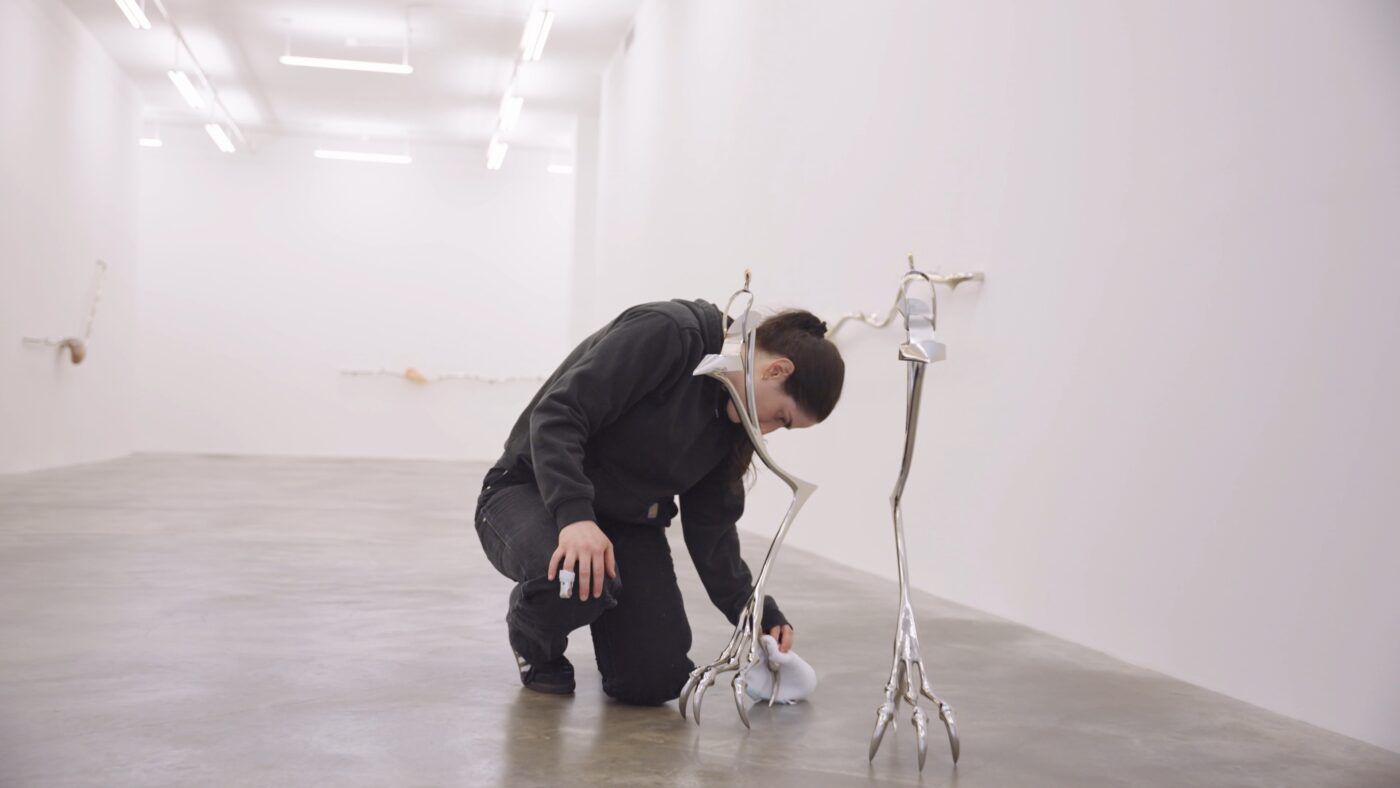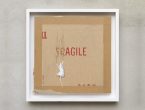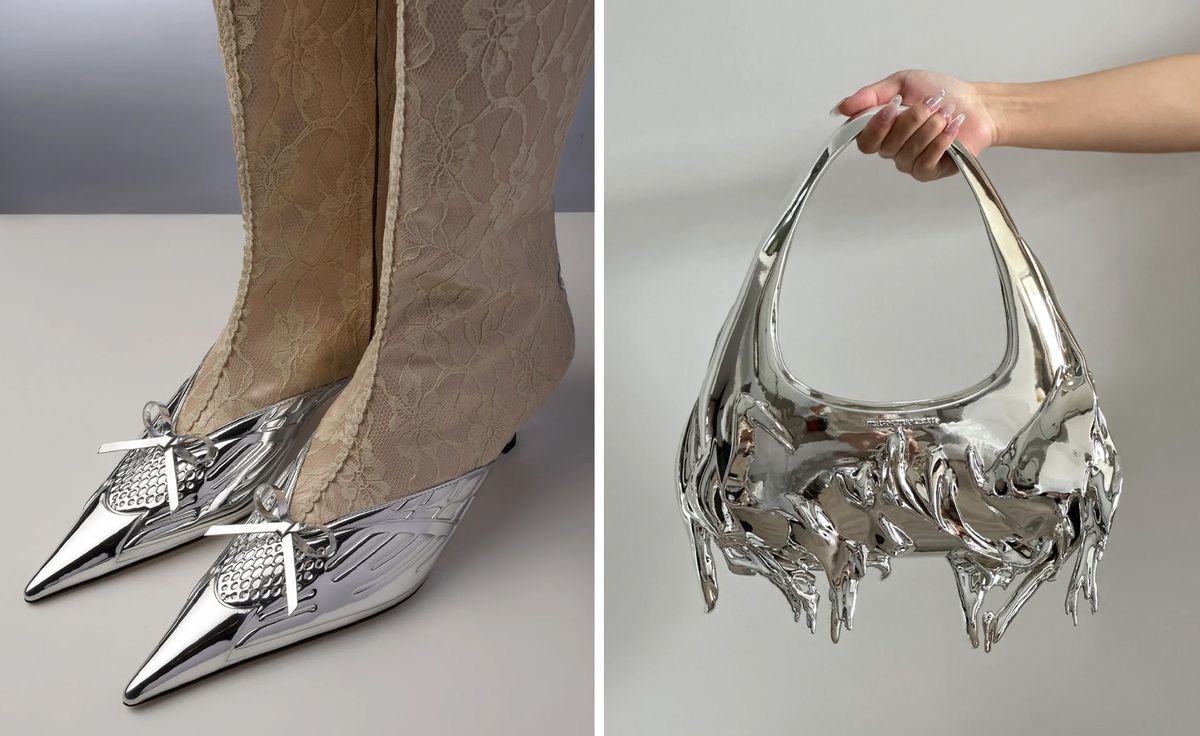A.P. (no.1)
2012 - Photography (Photography)
Erin Shirreff
Erin Shirreff’s A. P. series of prints investigates how objects are “constructed” at the level of the image. For each composite photograph, Shirreff fabricates two sculptural forms from what appear to be metal or plaster, although the precise materials are unidentified. Her sculptures resemble miniature architectural models or renderings of buildings as-yet-to-be fully conceptualized, both elemental and elegant in their use of sharp angles and clean lines. Shirreff then photographs each object against a similarly monochromatic backdrop in her studio, printing each image in rich and high-contrast greyscale. Next, she folds each print in half vertically so that the objects depicted in the image appear to be bisected. Finally, she adjoins the two folded prints at the edge of the fold, creating a new pictorial form from the two bisected images. The hybridized forms depicted in her prints resemble a jarring juxtaposition of geometric sturdiness and malleable plasticity, a cross between Tony Smith’s monolithic minimalism and Alexander Calder’s surreal wiriness. Shirreff uses photography here to imagine sculptural forms that do not exist in real life, and her work employs an illusionistic quality indebted to artistic traditions of trompe l’oeil. But Shirreff also reveals the artifice behind these images, suggesting that all pictorial representations are constructed and, in effect, can never fully document or replicate the experience of encountering an object in “real” perceptual space.
Erin Shirreff creates composite images that interrogate presumed boundaries between artifice and documentary. Originally trained as a sculptor, she works in the expanded field of photography, video, and sculpture, and her practice frequently employs multiple fine arts disciplines at once. Her work reconsiders the limits of sculptural practice by showing how image-based media can effectively be used to render hybridized shapes that do not (and arguably cannot) exist in real life. At the same time, she also reveals how these images are always deliberately constructed, leaving fold lines exposed and obvious discontinuities and aberrances in her composites. In leaving these artificial traces behind, Shirreff’s reminds us that images are always fabricated on some level and that representation itself is an artifice at its core.
Colors:
Related works sharing similar palette

© » KADIST
Emma Wolukau-Wanambwa
2005A short video about Tate Modern by Emma Wolukau-Wanambwa depicts just two shots, both featuring the artist...

© » KADIST
Gan Chin Lee
2019In Studies of Chinese New Villages II Gan Chin Lee’s realism appears in the format of a fieldwork notebook; capturing present-day surroundings while unpacking their historical memory...

© » KADIST
Bruce Conner
1995Bruce Conner is best known for his experimental films, but throughout his career he also worked with pen, ink, and paper to create drawings ranging from psychedelic patterns to repetitious inkblot compositions...

© » SLASH PARIS
40 ans du Frac ! — Gunaikeîon — Frac île-de-france, les Réserves — Exhibition — Slash Paris Login Newsletter Twitter Facebook 40 ans du Frac ! — Gunaikeîon — Frac île-de-france, les Réserves — Exhibition — Slash Paris English Français Home Events Artists Venues Magazine Videos Back 40 ans du Frac ! — Gunaikeîon Exhibition Mixed media Vue de l’exposition 40 ans du Frac ! — Gunaikeîon au Frac île-de-france, les Réserves, Romainville © Frac Île-de-France 40 ans du Frac ! Gunaikeîon Ends in 2 months: October 15, 2023 → February 24, 2024 Pour les 40 ans des Frac, il s’agit à la fois de repenser l’histoire de l’institution, écrite notamment par le biais de sa collection, et de tendre vers des futurs communs et désirables...

© » KADIST
Catherine Opie
1994Although best known as a provocateur and portraitist, Opie also photographs landscapes, cityscapes, and architecture...

© » KADIST
Nicolás Paris
2012Nicolas Paris studied architecture and worked as an elementary school teacher before he decided to become an artist...

© » ARTNEWS RETROSPECTIVE
Mary Weatherford Revisits an ARTnews Profile of Joan Mitchell – ARTnews.com Skip to main content By Alex Greenberger Plus Icon Alex Greenberger Senior Editor, ARTnews View All September 4, 2020 10:27am ©ARTnews In 1957, art critic Irving Sandler paid a visit to the studio of painter Joan Mitchell , an Abstract Expressionist known for her brushy images capturing nature...

© » KADIST
Andrea Bowers
2010The small drawings that comprise Study from May Day March, Los Angeles 2010 (Immigration Reform Now) and We Are Immigrants Not Terrorists are based on photographs taken at a political rally in downtown Los Angeles in which thousands of individuals demonstrated for immigrants’ rights...

© » LENS CULTURE
Cultural Changes at the Coldest Place on Earth — A Photo Story from Yakutsk - Photographs by Alex Vasyliev | Essay by Marigold Warner | LensCulture Feature Cultural Changes at the Coldest Place on Earth — A Photo Story from Yakutsk Photographer Alexey Vasyliev offers an intimate look into the life and changing culture of the Evens, an indigenous tribe in his hometown of Yakutsk — one of the coldest places on Earth...

© » ART21
Press Release: Art21 to Release New Film: “Hannah Levy’s Adaptive Structures” | Art21 Our Series Art in the Twenty-First Century Extended Play New York Close Up Artist to Artist William Kentridge: Anything Is Possible Specials Art21.live An always-on video channel featuring programming hand selected by Art21 Playlists Curated by Art21 staff, with guest contributions from artists, educators, and more Art21 Library Explore over 700 videos from Art21's television and digital series Latest Video 15:03 Add to watchlist Politics of Listening Lawrence Abu Hamdan Extended Play February 7, 2024 Search Searching Art21… Welcome to your watchlist Look for the plus icon next to videos throughout the site to add them here...

© » SLASH PARIS
40 ans du Frac ! — Gunaikeîon — Frac île-de-france, les Réserves — Exposition — Slash Paris Connexion Newsletter Twitter Facebook 40 ans du Frac ! — Gunaikeîon — Frac île-de-france, les Réserves — Exposition — Slash Paris Français English Accueil Événements Artistes Lieux Magazine Vidéos Retour 40 ans du Frac ! — Gunaikeîon Exposition Techniques mixtes Vue de l’exposition 40 ans du Frac ! — Gunaikeîon au Frac île-de-france, les Réserves, Romainville © Frac Île-de-France 40 ans du Frac ! Gunaikeîon Encore 2 mois : 15 octobre 2023 → 24 février 2024 Pour les 40 ans des Frac, il s’agit à la fois de repenser l’histoire de l’institution, écrite notamment par le biais de sa collection, et de tendre vers des futurs communs et désirables...

© » KADIST
John Wood and Paul Harrison
1996One of John Wood and Paul Harrison’s earliest works, Device features Harrison performing a series of actions, assisted by the titular ‘devices’, that use physics to force his body into unusual and uncomfortable positions...

© » ARTFORUM
Title, Theme Announced for Sixth Aichi Triennale – Artforum Read Next: ART BASEL REVEALS EXHIBITOR LIST FOR 2024 SWISS FAIR Subscribe Search Icon Search Icon Search for: Search Icon Search for: Follow Us facebook twitter instagram youtube Alerts & Newsletters Email address to subscribe to newsletter...







